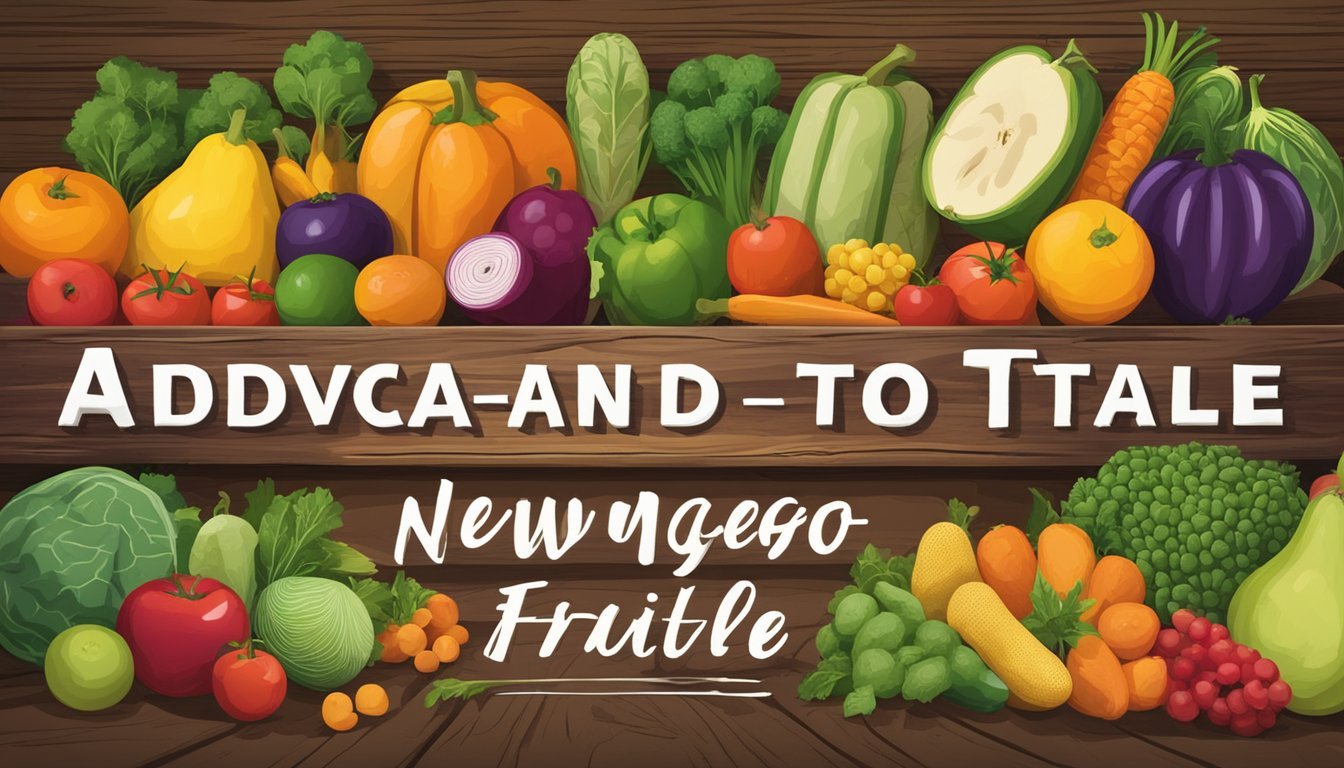New Mexico Seasonal Fruit & Veg Guide
Your Essential Calendar
New Mexico's unique climate and rich soil make it an ideal location for a variety of fruits and vegetables to flourish throughout the year. With a heightened interest in sustainable eating practices, the state has become a significant proponent of the farm-to-table movement. This approach not only supports the local economy and farmers within New Mexico communities but also ensures that residents and restaurants have access to fresh, seasonal produce, contributing to healthier lifestyles and more flavorful dishes.
As the seasons change, so does the harvest calendar, guiding the array of produce that ends up on New Mexicans' tables. Spring introduces a diversity of fruits and vegetables, while summer is hailed for its succulent stone fruits, like peaches, which peak in July and August. Each season holds its own bounty, which can be directly enjoyed by the community. This seamless transition from farm to table reflects the state's commitment to food that is both nourishing and in harmony with the environment.
Incorporating these seasonal offerings into daily meals not only showcases New Mexico's agricultural richness but also fosters a connection between growers and consumers, fortifying community bonds. As more individuals lean towards knowing the origin of their food, New Mexico serves as a prime example of how integrating locally-grown produce can enrich both the economy and the plate.
What’s in Season in New Mexico Right Now?
The Significance of Farm to Table in New Mexico
In New Mexico, farm to table is not merely a trend but an essential part of the state's culinary identity and agricultural economy. This model supports the rich cultural tapestry by bridging local produce with the community's dining tables.
Local Food Movement
New Mexico's farm-to-table movement is decidedly grounded in the idea that locally grown foods are a cornerstone of the region's heritage. Restaurants throughout the state take pride in crafting menus that honor this principle, featuring ingredients that reflect the rich biodiversity of New Mexico. This movement isn't just about fresh flavor profiles; it's also a form of advocacy for food education and promoting the region's unique agricultural narrative.
Community Support: By incorporating home-grown chiles, beans, corn, and other staples, farm-to-table eateries foster a resilient local food community.
Education: Alongside nonprofit associations, many restaurants participate in educating patrons about the importance of sustainable agriculture.
Benefits for Consumers and Farmers
Farm to table yields benefits for both consumers and farmers. Consumers enjoy access to fresh, seasonal produce that's full of flavor and nutrition while understanding where their food originates. Farmers, on the other hand, gain a dependable market for their products, which helps to maintain agricultural traditions and knowledge that might otherwise be lost.
Health: Fresh, minimally processed foods from local farms represent healthful choices readily available to New Mexicans.
Cultural Heritage: Farm-to-table reinforces the state's agricultural heritage, ensuring that traditional farming methods continue to flourish.
Economic Impact on the State
The economic implications of New Mexico's farm-to-table scene are significant. By sourcing food locally, restaurants inject money directly into the state’s economy, strengthening rural communities and fostering the overall vitality of the state's food system.
Monetary Circulation: Dollars circulate within the state, benefiting local farmers and businesses.
Rural Development: Sustained demand for local produce can lead to increased investment in rural farming communities.
Farm-to-table goes beyond simply serving and consuming food in New Mexico; it represents a deep-seated commitment to the prosperity of the state, its farmers, its cuisine, and its community at large.
Seasonal Calendar for New Mexico Produce
New Mexico's diverse climate creates a unique tapestry of produce availability throughout the year, each season offering a distinctive range of fruits and vegetables. Consumers and chefs alike can rely on this calendar for planning meals around the freshest local ingredients.
Spring Selections
In spring, New Mexico welcomes a variety of crisp vegetables and early fruits. March sees the arrival of:
Asparagus
Spinach
By April and May, one can expect:
Strawberries
Cherries
These months mark the beginning of a fruitful period for fresh salads and the first sweet treats of the year.
Summer Abundance
The summer months in New Mexico are bountiful, bringing an abundance of produce. From June through August, look for:
Tomatoes
Peaches
Melons
The fields and orchards are lush, and farmers' markets are at their peak with a colorful selection of summer squash, cucumbers, and plums.
Fall Harvest
Fall in New Mexico is a time for hearty harvest, with September to November offering a new assortment of flavors:
Apples
Pears
Pumpkins
Root vegetables like carrots and sweet potatoes also make their prominent appearance, perfect for robust autumnal dishes.
Winter Offerings
Even in the chill of winter, New Mexico fields yield produce. From December to February, residents can enjoy:
Pecans
Winter Squash
While the selection may be less varied than other seasons, these winter offerings provide a base for nutritious and comforting meals.
Key Produce in New Mexico by Season
New Mexico's diverse climate allows for a range of produce to flourish throughout the year. This section provides a glimpse into the key fruits and vegetables that are in season at various times, along with a spotlight on the vibrant herbs and greens available.
Fruits Highlight
Spring to Summer:
Peaches: Ripe and juicy, typically harvested starting late June.
Raspberries: They begin to ripen in June, offering a sweet-tart flavor.
Fall:
Apples: Harvest begins in late summer and extends through fall.
Year-Round:
Some greenhouse-grown fruits like strawberries may be available.
Vegetable Varieties
Spring:
Lettuce and Spinach: Tender greens thrive in spring's cooler temperatures.
Peas and Radishes: These crops are usually ready by late spring.
Summer:
Tomatoes: A summer favorite, ripening mostly in July and August.
Zucchini and Cucumbers: Summer is prime time for these vegetables.
Green Beans: They start to become plentiful in summer months.
Fall:
Carrots and Squash: Root vegetables and squash come into season.
Winter:
Kale and Collard Greens: Hardy greens that can withstand colder temps.
Herbs and Greens
Year-Round:
Herbs: Many such as cilantro and oregano are available in most seasons.
Spring to Fall:
Salad Greens: A variety of greens like arugula can be found.
Cooking Greens: Greens such as chard are harvested throughout these seasons.
Farming Techniques and Sustainability
New Mexico farmers are adopting sustainable practices to maintain soil health and ensure water efficiency. They emphasize the production of healthy foods using methods that are designed to protect the environment and adhere to responsive food policies.
Agricultural Practices
In New Mexico, farmers utilize crop rotation and integrated pest management to improve soil health and reduce the need for chemicals. These practices help sustain the land's productivity for future generations. Farmers also plant cover crops to enhance soil fertility and prevent erosion, directly contributing to the sustainability of their farms.
Irrigation and Water Use
Water is a critical resource in New Mexico's arid climate. Sustainable irrigation techniques such as drip irrigation and the use of non-potable water for crops are common. Farmers collect rainwater and implement efficient water usage policies to ensure that agriculture does not strain local water supplies.
Organic Farming
Many farms in New Mexico are certified organic, using no synthetic fertilizers or pesticides. They focus on growing healthy foods by employing natural fertilizers, such as compost and manure, that also enrich the soil. This adherence to organic standards supports a more sustainable food system and aligns with environmentally friendly food policy.
Supporting Local: Farmers' Markets and Restaurants
In New Mexico, the dedication to local food systems is evident through the strong network of farmers' markets and a variety of restaurants committed to farm-to-table principles. These entities are fundamental in bolstering community health, ensuring equity in food distribution, and maintaining economic livelihoods for local farmers.
Restaurants Featuring Farm to Table
Restaurants in New Mexico have embraced the farm-to-table approach, foregrounding relationships with local farmers to source fresh produce. This partnership benefits both the community and the environment, by reducing food miles and supporting local economies. Farm to Table is not just a concept but a practice executed by chefs and restaurant owners who prioritize serving healthy foods direct from local producers to their customers' plates.
Local Farm-to-Table Establishments:
The Greenhouse Bistro & Bakery: Emphasis on organic ingredients and seasonal harvests.
Loyal Hound Pub: Offers a rotating menu featuring local produce.
Local Markets and Direct Sales
Farmers' markets and direct sales form the backbone of New Mexico's local food movement. They provide a platform for farmers to sell their produce directly to consumers, ensuring that the majority of the financial gain stays within the local community. These markets are also essential for effective community engagement, raising awareness about the benefits of eating locally-produced food, and fostering a connection between consumers and their food sources.
Key Local Markets:
Santa Fe Farmers’ Market: One of the largest in the state, with a wide array of local produce.
Albuquerque Downtown Growers' Market: Offers fresh, seasonal produce and contributes to local food equity.
The synergy between farmers, markets, and restaurants in New Mexico not only helps in sustaining local agricultural practices but also plays a critical role in nurturing a community-minded food culture.
Nutritional and Health Considerations
Consuming fresh produce from a farm-to-table approach in New Mexico provides multiple health benefits due to the variety of nutrients present in seasonal fruits and vegetables. A diet rich in these foods can enhance overall health, as they are typically low in calories and high in fiber, vitamins, and minerals.
Fruits like apples, peaches, and berries offer an abundance of vitamin C and antioxidants, which are crucial for immune function and may reduce the risk of chronic diseases. The state's warm climate allows for a lengthy growing season, enhancing the nutrient profile of the produce.
Vegetables such as leafy greens and root vegetables are harvested at their nutritional peak, ensuring they are packed with vitamins A and K, iron, and potassium. These nutrients support vision health, blood clotting functions, and proper heart and muscle function.
Health Considerations:
Choosing locally grown produce ensures higher nutrient retention since the time from harvest to consumption is significantly reduced.
Eating a variety of colors in fruits and vegetables maximizes the range of nutrients consumed, promoting a balanced diet.
Integrating fresh produce into meals can aid in maintaining a healthy weight due to the high fiber content, which contributes to a feeling of fullness.
Healthy Foods: Fresh, local produce supports a health-conscious diet. Consumers opting for farm-to-table options in New Mexico are more likely to encounter foods free of preservatives, which aligns with a clean eating approach.
In sum, incorporating New Mexico's seasonal fruits and vegetables into one's diet supports a health-focused lifestyle, catering to the body's nutritional needs while fostering local agriculture.
Advocacy and Education
In New Mexico, the intersection of advocacy and education forms the backbone of advancing seasonal farm-to-table fruit and vegetable initiatives. These efforts are crucial for supporting local agriculture and ensuring equitable access to fresh produce.
Food Policy and Community Initiatives
Organizations in New Mexico are actively engaging in advocacy to influence food policy, aiming to establish sustainable and equitable food systems. They collaborate with policymakers to secure funding and legislative support for programs that integrate local produce into school meals and reduce barriers for farmers entering local markets. Community initiatives include Food and Farms Day, an event for raising awareness and appreciation of regional agricultural efforts. These initiatives are rooted in a desire to bolster economic opportunities for local farmers while ensuring that communities have access to nutritious, locally grown food.
Educational Programs for Agriculture
Nonprofits and associations in New Mexico prioritize education, providing resources and training for farmers and ranchers. They offer agricultural education programs focused on best practices for harvesting, packing, and meeting growing standards required by institutions. This training extends to assistance with bidding, production planning, and navigating the off-season to meet market demand. By equipping local agricultural professionals with the necessary skills and knowledge, these programs aim to strengthen the farm-to-school pipeline, enhancing the ability of educational institutions to serve NM-grown produce in school meals. This educational outreach fosters a well-informed agricultural community committed to the farm-to-table movement.
Regional Highlights Within New Mexico
New Mexico's diverse landscapes offer a variety of unique agricultural products. From the high-altitude farms in the north yielding distinct flavors, to the southern regions with their own special produce, each area contributes to the rich tapestry of local foods.
Northern New Mexico Specialties
In Northern New Mexico, communities cultivate crops that have been sustained through centuries of traditional farming practices. The region is known for its Heirloom Chimayo chile peppers, which boast a flavor profile that encapsulates the terroir of the high desert. Española, a city pivotal to the agricultural community, often features farm-to-table dishes that highlight these chile peppers. Farms here also produce apples, peaches, and cherries that are celebrated at local markets and festivals.
Unique Offerings of Southern Regions
Southern New Mexico
Challenges and Opportunities in New Mexico Agriculture
New Mexico agriculture is at a critical crossroads, facing challenges such as dwindling water resources and an aging farming population while also encountering distinct opportunities for sustainable growth and community engagement.
Addressing Farming Challenges
Aging Farmers: With an increasing age demographic among farmers and ranchers, New Mexico confronts the urgent need for the transfer of knowledge and land to younger generations. This situation necessitates tailored education programs to prepare new farmers for future challenges.
Resource Scarcity: The state's agricultural sector struggles with limited water supply and higher production costs. Strategies such as innovative water management and energy-efficient practices are essential to maintain the viability of farming in New Mexico.
Economic Pressures: Rising land costs and complex regulations add to the economic hurdles, potentially jeopardizing the continuity of traditional farming operations. Addressing these economic challenges is pivotal to ensuring sustainable farmer and rancher incomes and the industry’s resilience.
Community Involvement: The sector requires enhanced community support to tackle these obstacles. Collaborative approaches in planning and decision-making can lead to more robust defense mechanisms against such industry threats.
Emerging Opportunities for Growth
Regenerative Agriculture: There is a growing trend towards regenerative agriculture in New Mexico, with farmers like those at Barnhouse Farms adopting practices that improve land health. This shift presents a significant opportunity to enhance both ecological sustainability and farm productivity.
Economic Contribution: Agriculture remains a crucial economic driver, supporting over 23,000 jobs and generating substantial revenue. By embracing modern techniques and diversifying products, the industry can further solidify its economic impact.
Educational Outreach: Increased focus on agricultural education can equip new farmers with the skills needed to innovate and adapt, fostering a resilient agricultural community. This also includes promoting farm-to-table initiatives that strengthen the link between producers and consumers.
By confronting its challenges head-on and capitalizing on new opportunities for growth, New Mexico agriculture can pave the way for a sustainable and prosperous future.











